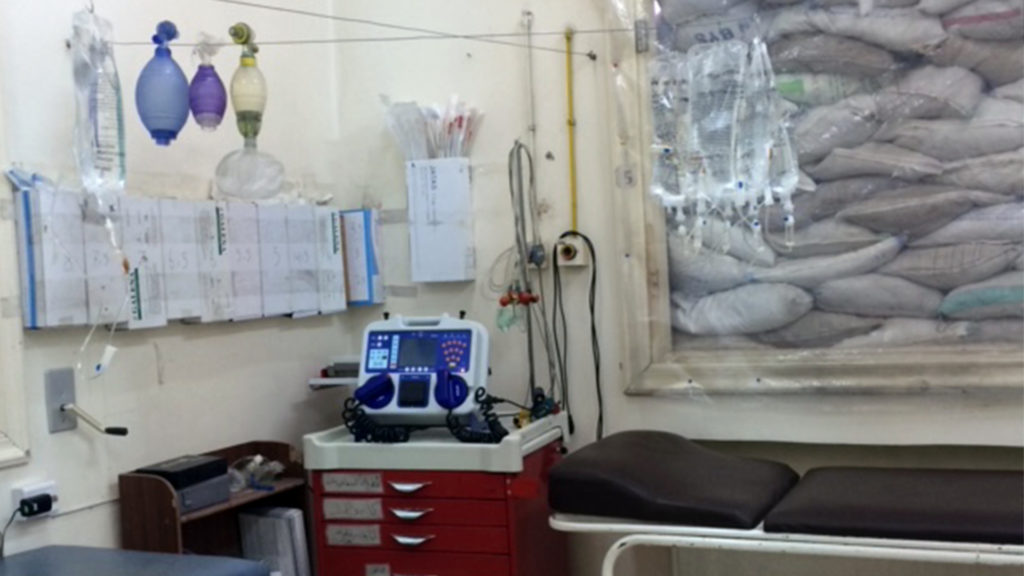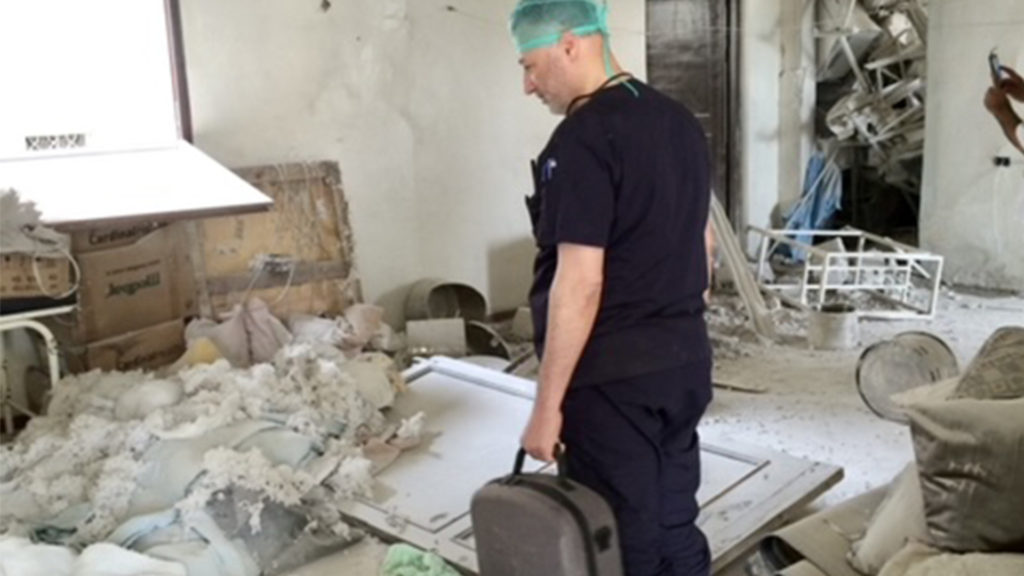Against all odds, medical professionals and aid workers tried to alleviate Syria’s suffering. But the answer to the country’s agony is not in any medical textbook

In the spring of 2014, at the peak of the war in Syria, I left Chicago to volunteer as a critical care specialist at the Al-Sakhour Hospital in Aleppo. The hospital building had three stories with an emergency room in the basement. From the inside, it looked like any emergency room in Chicago. It was equipped with an otoscope, light source, suture kits, defibrillator, intravenous lines, manual resuscitation masks, and intravenous fluids. But the clerestory windows were blocked by sandbags from the outside to protect patients and doctors from shrapnel. The hospital had been bombed several times.
Aleppo was the epicenter of the Syrian crisis and the most dangerous city in the world. It was divided into a western half controlled by the regime and an eastern half controlled by rebels. The front line ran through the middle of the historic old city with the Aleppo Citadel in the center. Civilians who tried to cross were shot at by regime snipers.
I crossed the border from Turkey at Bab Al-Salamah and traveled south in an ambulance driven by a nurse from an Aleppo hospital. It was my second medical mission to the city. Rebels controlled the roads from Turkey to Aleppo, but regime militia and extremist groups made travel dangerous. There were also criminal gangs that exploited the situation and kidnapped people for ransom. We passed roadblocks controlled by masked men, each with a different flag.
I had left Chicago, the capital of gun violence in the U.S., and was about to enter Syria’s capital of the barrel bomb.

The barrel bomb — barmeel in Arabic — is a clumsy weapon. It is an improvised weapon, made from barrels of various sizes, packed with 150 to 500 kilograms of TNT mixed with fertilizers, diesel fuel, and aluminum powder for incendiary effect and pieces of scrap metal, nails, and rusty pipes to serve as shrapnel. They penetrate the bodies of victims, causing visible and invisible wounds. Many die from internal bleeding. The explosive mix is ignited by a long fuse before it is pushed off helicopters.
One helicopter can carry four to six such bombs. They are pushed from the open doors and take 20 to 30 seconds to reach the ground. They are unguided and indiscriminate. They come in many sizes. There was an extra-large one called the dumpster (haweya in Arabic), which is a big garbage dumpster filled with the same deadly stuff. The symbolism was not lost on the people.
According to the Syrian Network for Human Rights, regime forces dropped 81,916 such bombs from July 2012 to April 2021, killing 11,087 civilians, including 1,821 children and 1,780 women. They were used in no fewer than 565 attacks on vital civilian facilities, including 76 medical facilities, 140 schools, 160 mosques, and 50 markets.
It did not take long for me to be introduced to the deadly effects of this crude weapon.
Shortly after arriving in Aleppo, I was sipping a cup of Arabic coffee in the humble physicians’ lounge when I heard a commotion. I rushed to the emergency room and saw a young boy lying on the exam table. His black pants were covered in white dust. His upper torso was exposed. He was in severe pain.
Abdallah, 12, was injured by a barrel bomb while playing in the street near the hospital. Shrapnel had penetrated Abdallah’s right lung and liver, and a piece of metal had lodged in his belly. The nurse, Mohammed, inserted a tube in the right chest to release the air pressure. Local anesthesia and painkillers were unavailable. Abdallah screamed: “I kiss your hand, my uncle. Don’t hurt me. I want my mama.” A CT scan was needed to screen for internal injuries, but the only functioning one was located in Omar Bin Abdul Aziz Hospital in Al-Maadi district. Getting there would have exposed the child to further danger.
In the end, he was taken to the operating room and an experienced surgeon sutured a big tear in his liver and stopped the internal bleeding. Other victims were not so lucky. Jomaa, 13, was pulled from the rubble of his family’s humble apartment with crush injury, multiple fractures, and lung contusions. He was in a coma and placed on life support. He did not make it.
I spent the night in the medical building near Bin Abdul Aziz Hospital in Al-Maadi district. I could see the Aleppo Citadel from the top of the building. Several buildings nearby were semi-destroyed. “It is the barrels,” said Dr. Mohamadein, my host. A skilled urologist, Mohamadein had left his lucrative practice in western Aleppo to join the medical teams on the eastern side out of a sense of duty. He was a bulky man with dark black eyes, thick eyebrows, stubble, and a scruffy look. He wore short-sleeved green medical scrubs and long boots. “Allah will protect you, inshallah,” he said.
I could not sleep that night. Every few minutes my room was shaken by explosions. The smell of cordite was in the air. I rushed out after one large explosion. “Don’t worry,” one of the doctors said. “We are very close to the front line. They target more distant neighborhoods,” he explained. The logic of his argument would only hit me later. The barrel bomb had no battlefield use since it was unguided and could hit one’s own troops, so it was used exclusively against civilians.
I was ready for work the next morning, hyper-alert despite the lack of sleep. I was ready to leave the building when Mohamadein rushed in. “Wait, wait,” he said. “They bombed Al-Zarzour Hospital with a barrel bomb.”
“What happened to Dr. Al-Hariri and the patients?” I asked.
“He survived,” said Mohamadein. “Some patients were injured, but I am not sure.”
I offered to help in the evacuation, but Mohamadein warned me about the “double-tap.” Regime planes often circled overhead, waiting for rescuers to gather before striking again.

Dr. Al-Hariri, the director of Al-Zarzour Hospital and Aleppo Medical Council, is a general surgeon trained at the University of Manchester, who had been practicing and teaching general surgery at the University of Aleppo medical school before the crisis. He was one of the few surgeons left in the city. They were overwhelmed by the flood of trauma cases and their limited resources.
Still in his dark blue surgical gear, Al-Hariri arrived in the medical building, a black walkie-talkie in one hand, a surgical light in the other. He carried it in case he had to operate without electricity. He has a sharp nose, clear gray-green eyes, and a lightly unshaven beard, his head covered in graying, light-brown hair. He was a natural leader; when he spoke, people listened.
He was at the hospital when the first bomb hit the roof, throwing him out of his chair. Flying glass penetrated the head of a patient in intensive care who was recovering from chest surgery carried out a day earlier. Al-Hariri and his team evacuated the hospital.
‘They drop 20 or 30 every day.’ Surprisingly, people carried on. It was just another day in Aleppo.
After waiting a couple of hours to avoid the second tap, we drove to the hospital. We saw children pointing to the sky, and we stopped to look. A helicopter was hovering high over the city. Al-Hariri said it was scouting for another target: “They drop 20 or 30 every day.” Surprisingly, people carried on. It was just another day in Aleppo.
“If your name is written on the barrel, it won’t miss you,” Al-Hariri joked.
Al-Zarzour Hospital was empty when we arrived. The street in front of the entrance was strewn with shattered glass and pieces of concrete. The upper floor was damaged, and the fuel and water tanks on the roof had been destroyed. The hospital was eerie and dark, littered with debris and broken glass. There were wrecked wheelchairs and broken monitors in the medical ward. Al-Hariri went to the operating room and stood there, looking defeated, ready to cry. He pulled a suture set from the ground and inspected a sterilizer. “They can be used,” he mumbled. He salvaged everything that was usable.
“Now what?” I asked.
“We’ll clean up the debris, fix the operating room, and get to work again,” he answered. “We can’t afford to stop.”
At the end of my mission to Aleppo, I asked Al-Hariri what we could do to help. He paused for a few seconds then whispered, “send us body bags. We ran out of them.” Nothing that I learned in medical school had prepared me for what I witnessed in Syria.
The year 2014 was labeled by locals as the year of the war on bakeries. President Bashar al-Assad’s warplanes targeted people standing in line waiting for bread; they also bombed farmers’ markets, schools, and hospitals. International humanitarian law had no purchase here. This was total war. Proscribed weapons such as sarin were freely deployed. The regime even weaponized chlorine.
Following every humanitarian mission, Syrian American leaders and I met with our senators and legislators, with State Department and National Security Council officials, to update them about the humanitarian situation on the ground. We shared our stories and showed them images of bombed hospitals and mutilated victims. Some had tears in their eyes. We asked them to do something to protect hospitals and civilians. We warned them of the exodus of a large number of Syrians if the attacks persisted. Their sympathy never translated into action.
On my return, I also testified to the U.S. House Committee on Foreign Affairs. I showed the members of Congress photos of Abdullah, Al-Hariri, and Al-Zarzour Hospital after it had been bombed.
“The number of people impacted by the Syrian crisis is more than those impacted by the crises in South Sudan, the Central African Republic, Bosnia, and Rwanda combined. We are talking about the worst humanitarian disaster in our time. I believe that our nation is able to do much more than what we have done in the past. I urge you to support humanitarian assistance to the Syrians, but I urge you also to do much more to end the crisis and force a political settlement.”
At the end of my testimony, Rep. Eliot Deutch from Florida summed the response of the U.S. administration:
“When you talk about the way the crisis in Syria is viewed, what we hear all the time is, well, it is really hard for us to know what to do because there are so many different people fighting one another and it is hard to tell who we can support, who are the worst parties, and so, therefore, we will try to help on a humanitarian level.”
Thousands of videos document the use of barrel bombs, including videos from inside the helicopters dropping them. Satellite imagery, open-source data, and flight pattern analysis has shown that less than 10 Mi-8 and Mi-17 helicopters were responsible for the barrel bombs and chlorine attacks that caused tens of thousands of civilian deaths. They were operated by the “Tiger Forces” (now called the 25th Special Mission Forces Division) and usually deployed in small squadrons from exposed airfields. This small fleet could’ve been easily eliminated or grounded, saving tens of thousands of lives.
Al-Assad’s strategy of depopulating opposition cities started with the indiscriminate barrel bombs and continued with precision strikes on hospitals and vital civilian infrastructure by Russian jets. Finally, Iraqi, Afghan, and Lebanese mercenaries led by Iranian commanders would besiege and terrorize the remaining civilians with a “surrender or starve” strategy. The formula played out in one besieged city after another.
Beyond words of condemnation, the international community offered little support to Syria’s battered and terrorized people. Since March 2011, fully half of the Syrian population has been displaced, 40% of whom are children. The overall civilian death toll from this war is estimated to be close to 600,000 including 55,000 children. An additional 6 million Syrians, one-third of the population, were displaced during the past four years alone. For every one refugee who returned to Syria in 2020, four Syrians were displaced.
In addition to millions of people dead or displaced, a recent report by World Vision International puts the economic cost of the decadelong Syrian war at more than $1.2 trillion. Even if the war ended today, there would be $1.4 trillion in additional losses up until 2035. The overall life expectancy of Syrian children has decreased by 13 years.
I have just returned from another medical mission to northwest Syria. My organization, MedGlobal, built two large oxygen generators to provide support for patients in two hospitals overwhelmed by COVID-19. Hospitals are chronically undersupplied. There are still 1.2 million civilians subsisting in more than 1,000 camps close to the Turkish border. Half of Idlib’s current population has been displaced from other parts of Syria and their future remains uncertain.
Yet, people are resilient. For the first time in 10 years, I saw some signs of normalcy. Students are going to school; new businesses and factories are opening; streets have cars assembled in Idlib; new restaurants are popping up. I had dinner in Idlib city at a place called Disney Restaurant, where children frolicked in the playground and vintage cars were on display. It felt good. This was different from my visit a year ago when the regime and Russia waged their last major bombing campaign against hospitals and schools, displacing 1.2 million more people. That offensive only ended after Russia bombed the Turkish military and, in retaliation, Turkey destroyed much of the regime’s military capability in Idlib.
I met with a doctor at a busy hospital where Idlib’s successful COVID-19 program is run. But Idlib’s biggest problems are more mundane. In the same hospital, I saw a two-year-old with severe malnutrition. Her pediatrician was explaining to her traumatized mother that he wanted to admit the girl for hydration and intensive nutritional treatment. She’ll likely not make it. Cases of malnutrition have been rising.
In a recent U.N. Security Council meeting, the current U.N. envoy for Syria called the conflict “one of the darkest chapters in recent history” and said the Syrian people were “among the greatest victims of this century.” He added: “Syrians have faced human rights violations on an enormous and systematic scale and endured countless violations of international law.”
Yet headlines have moved on while the survivors in Idlib remain in limbo. They may have gained some respite from al-Assad’s barrel bombs, but they face slow death from the lack of food and medication. And things are likely to get worse.
The international community sends food and medicine through one border crossing connecting Turkey to northwest Syria. Russia, the regime’s main ally, has been threatening to cut the only lifeline to the 4.2 million Syrian civilians trapped in Idlib by vetoing the Security Council resolution that allows cross-border humanitarian aid. This could lead to catastrophe. According to international NGOs, more than 1 million Syrians will go hungry, hospitals will be devastated by being deprived of medical supplies and vaccines in the middle of a pandemic, and tens of thousands of children will lose their education. Only urgent diplomatic effort at the Security Council can avert this.
According to the U.S. State Department, the Assad regime has never ceased hampering humanitarian organizations from delivering aid to millions of trapped Syrians. In areas held by the Syrian government, the regime is providing insufficient access through visa restrictions and other administrative obstacles. According to U.N. estimates, 11.1 million people in Syria — about two-thirds of the population — needed humanitarian aid in 2020, with more than half in state-controlled areas. Many of these communities are in urgent need because of prolonged periods under siege; the destruction of homes and infrastructure; limited livelihood opportunities; and a lack of basic services, such as health care and safe drinking water.
Syrians are caught between the overt violence of barrel bombs and covert killing through hunger and enforced privation. The barrel bombs may have become more sporadic, but shortages of food, medicine, and other basic necessities continue to inflict misery.
And to add insult to injury, the Syrian regime has been granted a seat on the executive board of the World Health Organization, which reported last fall that it had documented 494 attacks on health care facilities in Syria, mainly in areas under assault by al-Assad’s forces. The same regime that weaponized humanitarian aid, attempted to exploit the COVID-19 pandemic, and caused the largest displacement of people since the Second World War is being rewarded by the WHO, the organization that is supposed to enforce the norms for the global governance of health.
During his presidential campaign, Joe Biden met with Syrian American leaders and promised to address the Syrian crisis. His secretary of state, Antony Blinken, admitted that the Obama administration made “mistakes” in Syria. He promised to increase humanitarian assistance and support the Caesar Act, which mandates “diplomatic and coercive means,” such as sanctions, to hold al-Assad and his regime accountable. Blinken also pledged to lead a diplomatic effort to revitalize the stalled political process and implement Security Council Resolution 2254, which stipulates the only pathway for sustainable peace, national reconciliation, and a dignified return of refugees. It now has the opportunity to deliver on that promise.
Syria has exposed the fragility of international norms. Words have not alleviated its people’s suffering. Only action can give meaning to the words.
Adapted from its original source- Newlines Magazine
—————————————————————————————————————————————————————————–
Statements, comments or opinions published in this column are of those of the author(s) and do not necessarily reflect the editorial policy of Warsan magazine. Warsan reserves the right to moderate, publish or delete a post without prior consultation with the author(s). To publish your article or your advertisement contact our editorial team at: warsan54@gmail.com


